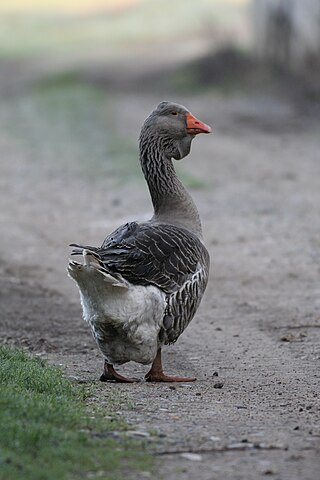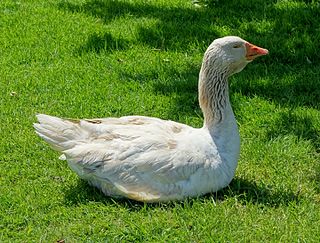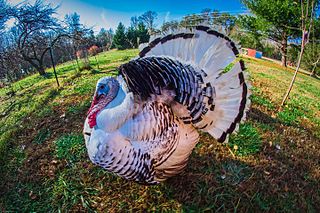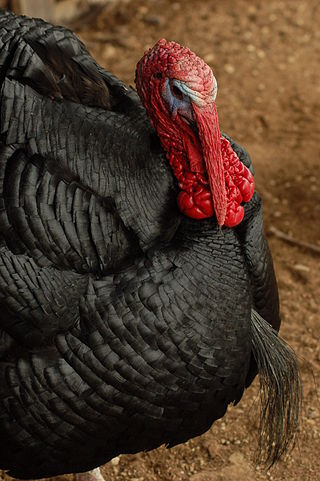
The Cotton Patch is a breed of domestic goose originating in the Southern United States. It is so named because it traditionally was used to weed fields of cotton, corn, and other crops.

The Cotton Patch is a breed of domestic goose originating in the Southern United States. It is so named because it traditionally was used to weed fields of cotton, corn, and other crops.
Up until the 1950s, Cotton Patch geese were customarily kept on rural Southern homesteads and farms as multi-purpose poultry used for weeding, meat, eggs, down, and grease. Their grazing kept fields clear of crabgrass and other weeds, while leaving crops unharmed and reducing the amount of manual labor necessary. After the mid-20th century, herbicides almost entirely replaced weeding on American farms, and the Cotton Patch goose declined in concert. Considered critically endangered by the American Livestock Breeds Conservancy, the Society for the Preservation of Poultry Antiquities, and the American Poultry Association, it has largely disappeared from the Southern farms where it was once common. It is also included in Slow Food USA's Ark of Taste, a catalog of heritage foods in danger of extinction.
The Cotton Patch goose is particularly well-adapted to the climate of the southeastern U.S., being more heat tolerant. They are also slimmer in body than most domestic geese, and retain a relatively good flying ability into adulthood. They much more closely resemble the wild forebears of domestic geese, the greylag goose. They are similar in color to the Pilgrim Goose and Shetland Goose, and are also sexually dimorphic. In general, ganders are white with some dove gray feathers on the back and tail. Females are either entirely gray, or pied gray and white, also called saddleback. The bills and feet are pink rather than orange, as is seen in the Pilgrim, which it resembles. They range in weight from 8-10 pounds for geese and 9-12 pounds for ganders.

The Chinese is an international breed of domestic goose, known by this name in Europe and in North America. Unlike the majority of goose breeds, it belongs to the knob geese, which derive from Anser cygnoides and are characterised by a prominent basal knob on the upper side of the bill. It originates in China, where there are more than twenty different breeds of knob goose.

The Randall Lineback or Randall is an American breed of cattle. It originated in Bennington County, Vermont, and is critically endangered.

The Toulouse is a French breed of large domestic goose, originally from the area of Toulouse in south-western France. Two types are recognised: a heavy industrial type with dewlaps, the French: Oie de Toulouse à bavette; and a slightly lighter agricultural type without dewlaps, the French: Oie de Toulouse sans bavette. Both types are large, with weights of up to 9 kg. Birds bred in the United Kingdom and United States exclusively for showing may be still larger, and have a somewhat different conformation.

The Orpington or Buff Orpington Duck is a breed of domestic duck. It is a dual-purpose breed used for meat and egg production. It is capable of laying up to 220 eggs a year. Originally created by William Cook of Orpington, Kent, England, from the selection of mis-marked Blue Orpington Ducks; Cook was also the developer of the Orpington chicken. The breeds used in the development of the breed included Cayuga, Indian Runner, commercial Aylesbury and Rouen. It is proposed that Cook's intentions for the breed were to capitalize on the growing demand for the buff colour pattern. The Buff Orpington Duck was introduced to the public at the Dairy Show, the Agricultural Hall (q.v.), Islington, London in October 1897. It is considered a threatened breed by the ALBC. This breed was admitted to the British Poultry Standard in 1910 and the American Poultry Associations Standard of Perfection as the 'Buff Duck' in the Medium class in 1914. The Orpington duck is available in three colour varieties: Buff, Blond and Brown. The Buff Orpington is an unstable colour due to a blue dilution gene which means that from the offspring, all three colour variations will appear.

The American Buff is an American breed of domestic goose. It was accepted by the American Poultry Association in 1947. It is named for its single plumage variety, which is a pale buff or apricot-fawn in color.

The Bourbon Red is an American breed of domestic turkey. It is named for its reddish-brown plumage and for its area of origin, Bourbon County, Kentucky, where it was developed in the last years of the nineteenth century. It was accepted into the Standard of Perfection of the American Poultry Association in 1909, and in the early twentieth century was an important commercial meat breed until the Broad Breasted White began to dominate industrial production. The Bourbon Red is considered a heritage turkey; it is an endangered breed, classified as 'watch' by the Livestock Conservancy. It was formerly known as the Bourbon Butternut or as the Kentucky Red.

The African or African Goose is a breed of domestic goose. It is one of two domestic breeds that derive from the wild species Anser cygnoides, the other being the Chinese; all other domestic geese derive from Anser anser. Despite the name, it is not from Africa but is of Asiatic origin. It is a large bird, among the heaviest of all goose breeds.

Pilgrim geese is a breed of domestic goose. They are considered to be a relatively quiet, lightweight and medium-sized breed. The pilgrim goose is a rare and critically endangered species according to the American Livestock Breeds Conservancy (ALBC) and was officially entered into the American Poultry Association's Standard of Perfection in 1939. Generally, they can live for 15 to 25 years. In most breeds of geese, males and females are indistinguishable from one another; however, the pilgrim goose is well known for its auto-sexing trait. Males are characterised by white feathers while the females have grey. This sexual dimorphism makes pilgrim geese desirable for breeding as the sexes are easily determined. Their commercial use is primarily limited to the United States where they are bred for eggs and meat. They are known to grow relatively fast and are easy to handle.

The Red Wattle Hog is a breed of domestic pig originating in the United States. It is named for its red color and distinctive wattles or tassels, and is on the threatened list of the American Livestock Breeds Conservancy (ALBC).

The Buckeye is an American breed of chicken. It was created in Ohio in the late nineteenth century by Nettie Metcalf. The color of its plumage was intended to resemble the color of the seeds of Aesculus glabra, the Ohio Buckeye plant for which the state is called the 'Buckeye State'.

The Delaware is a breed of chicken originating in the U.S. state of Delaware. It was once of relative importance to the U.S. chicken industry, but today is critically endangered. It is primarily suited to meat production but also lays reasonably well. It has plumage of a unique pattern, and is accepted into poultry standards for showing.

The Royal Palm is a breed of domestic turkey. It is not primarily selected for meat production, and is usually kept as an ornamental bird with a unique appearance, largely white with bands of metallic black.

The Pomeranian goose, also known as the Rügener goose, is a breed of domestic goose.

A heritage turkey is one of a variety of strains of domestic turkey which retains historic characteristics that are no longer present in the majority of turkeys raised for consumption since the mid-20th century. Heritage turkeys can be differentiated from other domestic turkeys in that they are biologically capable of being raised in a manner that more closely matches the natural behavior and life cycle of wild turkeys. Heritage turkeys have a relatively long lifespan and a much slower growth rate than turkeys bred for industrial agriculture, and unlike industrially bred turkeys, can reproduce without artificial insemination.

The Norfolk Black, also known as the Black Spanish or Black Turkey, is a British breed of domestic turkey. It is thought to derive from birds taken to Britain from Spain, where they had arrived with Spanish explorers returning from the New World.
The Shetland goose is a breed of domestic geese that originates in the Shetland Islands of Scotland. Like the other breeds of livestock native to the islands, the Shetland goose is small in stature, generally weighing between 12 and 14 pounds. They are very hardy and exceptionally good foragers, and are able to largely sustain themselves through grazing.
The Buff or Jersey Buff is a breed of domestic turkey named for its buff-colored plumage.

The Ossabaw Island Hog or Ossabaw Island is a breed of pig derived from a population of feral pigs on Ossabaw Island, Georgia, United States. The original Ossabaw hogs are descended from swine released on the island in the 16th century by Spanish explorers. A breeding population has been established on American farms off the island, but they remain a critically endangered variety of pig.

The Midget White is a breed of domestic turkey named for its white plumage and small stature. The breed is the smallest standard variety of turkey, and with toms at roughly 13 lbs and hens 8-10 lbs, it weighs only slightly more than the largest chickens.